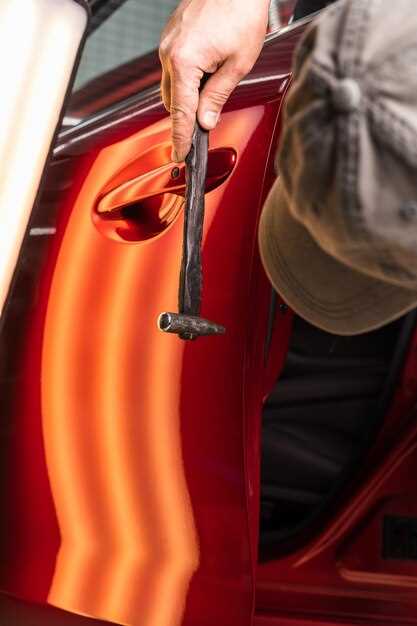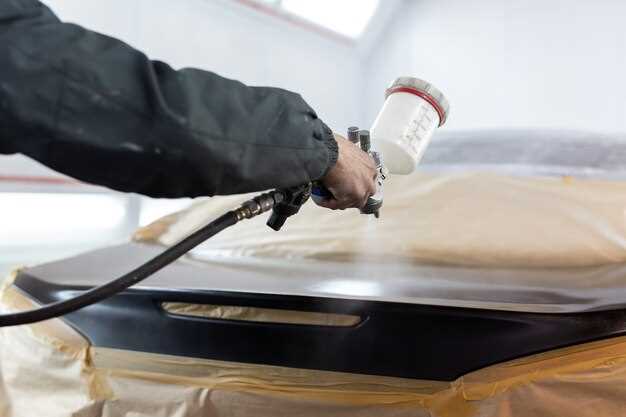
Restoring the paint finish on your Corrado not only enhances its visual appeal but also protects the underlying materials from environmental damage. Over time, exposure to the elements can lead to faded colors, dullness, and even scratches on the surface. To bring back the original luster, a careful approach to polishing is essential.
This step-by-step guide will walk you through the process of revitalizing your Corrado’s paint finish. We will cover everything from assessing the current state of the paint to selecting the right polishing products and techniques. Understanding each phase of the restoration process ensures that you achieve a stunning, long-lasting finish without causing any harm to your vehicle’s exterior.
Whether you’re a seasoned car enthusiast or a novice looking to enhance your car care skills, our detailed instructions will help you navigate the intricacies of paint restoration. Let’s get started on the journey to rejuvenate your Corrado’s paint and restore its classic charm.
Assessing the Current Condition of Your Paint
Before initiating any restoration procedure, it’s crucial to accurately assess the current condition of your car’s paint. Understanding the state of your paintwork will help determine the appropriate steps needed for effective restoration.
Start by examining the surface under natural light to reveal any imperfections. Look for scratches, chips, oxidation, and swirl marks. Each of these flaws affects the overall appearance and can impact how well polishing will restore the finish. Take notes on the severity of these issues to formulate a restoration plan.
It’s beneficial to categorize the paint condition using a simple scale from 1 to 5, where 1 represents heavily damaged paint and 5 indicates a nearly perfect finish. This categorization can guide you in selecting the right products and techniques for polishing.
| Condition Level | Description | Recommended Action |
|---|---|---|
| 1 | Severe scratches and oxidation | Consider professional restoration |
| 2 | Deep scratches, significant fading | Heavy polishing and compounding needed |
| 3 | Minor scratches and dullness | Moderate polishing with fine products |
| 4 | Minor imperfections, good gloss | Light polishing to enhance shine |
| 5 | Near new condition | Optional maintenance polish |
In conclusion, assessing your paint’s current condition is a pivotal first step in the restoration process. By identifying specific issues and categorizing the level of wear, you can effectively plan your approach to polishing and ultimately restore your Corrado’s paint finish to its former glory.
Gathering Necessary Tools and Products for Polishing
Before starting the polishing process on your Corrado, it’s essential to gather all necessary tools and products for effective paint correction. This ensures a smoother workflow and optimal results.
Begin with a dual-action polisher, which provides both safety and efficiency. This tool minimizes the risk of damaging your paint while allowing for effective correction. Pair it with a selection of polishing pads, including cutting, polishing, and finishing options. Each pad serves a different purpose in the correction process, so choose based on the condition of your paint.
Next, select quality polishing compounds. A cutting compound is crucial for initial correction of deep scratches and imperfections. Follow it up with a refined polishing compound to enhance the shine and remove any haze left behind. Ensure the products you select are compatible with your paint type for optimal results.
Additionally, invest in microfiber towels for cleaning and buffing. These are gentle on the paint and help to avoid swirling. A clay bar kit is also recommended for decontaminating the surface before polishing. It effectively removes embedded contaminants, allowing for a smoother finish.
Lastly, don’t forget about protective gear. Gloves and a mask are essential for personal safety when handling various products and compounds. Ensure your workspace is well-lit and ventilated to facilitate an efficient and safe polishing process.
Step-by-Step Guide to Washing and Preparing the Surface

Before beginning any paint correction process on your Corrado, it’s essential to properly wash and prepare the surface. This ensures that you remove any contaminants that could interfere with the paint application.
Start by gathering your supplies: a high-quality car wash soap, two buckets (one for soapy water and the other for rinsing), a microfiber wash mitt, wheel cleaner, and microfiber towels. It’s important to use products specifically designed for automotive finishes to avoid damaging the paint.
Begin by rinsing the entire vehicle with a hose or pressure washer. This will remove loose dirt and debris. Focus on the wheels first, applying a dedicated wheel cleaner with a brush to eliminate brake dust and grime. Rinse thoroughly to ensure all cleaning agents are washed away.
Next, fill one bucket with warm water and car wash soap, and the other bucket with clean water for rinsing your wash mitt. Starting from the top of the car and working your way down, use the soapy wash mitt to gently clean the surface, applying light pressure to avoid scratches. Frequently dip the mitt into the rinse bucket to remove any dirt before returning to the soapy water.
Once the entire vehicle is washed, thoroughly rinse it again with clean water to remove any soap residue. This step is crucial as soap residue can hinder paint correction later on.
After rinsing, dry the surface using clean microfiber towels. It’s important to pat rather than wipe to prevent swirls or scratches. Pay extra attention to areas with complex contours where water may accumulate.
Finally, inspect the surface for any remaining contaminants such as tar, sap, or industrial fallout. If found, use a clay bar or a dedicated decontamination product to remove these stubborn residues. Lubricate the surface adequately during this process to prevent further scratching.
With the surface properly washed and decontaminated, you are now ready to begin the paint correction process. An adequately prepared surface will maximize the effectiveness of paint correction techniques and deliver a smoother, glossier finish on your Corrado.
Applying Compound for Paint Correction: Techniques and Tips

Applying compound is a crucial step in the paint correction process for your Corrado, helping to restore the finish and enhance the overall appearance. Here are essential techniques and tips to achieve optimal results:
- Choose the Right Compound: Select a compound appropriate for your paint type and the level of correction required. Soft compounds are ideal for minor imperfections, while more aggressive formulas can tackle deeper scratches.
- Gather Tools:
- Dual-action polisher or rotary polisher
- Foam or wool polishing pads, depending on the compound used
- Microfiber towels for wiping off residue
- Pail of clean water for rinsing pads
- Masking tape to protect non-painted areas
- Prepare the Surface: Thoroughly wash and dry the car before applying the compound. Use clay bar treatment to remove contaminants for a smooth finish.
- Test a Small Area: Before applying compound to the entire surface, test it on a less visible area to ensure compatibility and desired results.
- Apply Compound:
- Apply a small amount of compound onto the pad or directly onto the surface.
- Spread the compound evenly across the area before activating the polisher.
- Start with a low speed to minimize splatter, then gradually increase to a medium speed for effective polishing.
- Work in Sections: Break down the surface into manageable sections. This allows you to focus on each area and ensures thorough correction.
- Use Proper Technique:
- Keep the polisher moving to avoid burning the paint.
- Use a cross-hatch pattern for even coverage, working in linear motions.
- Apply moderate pressure, allowing the compound to work without excessive force.
- Inspect and Repeat: After polishing, wipe the area with a microfiber towel to inspect your work. If imperfections remain, repeat the process as needed with subsequent polishing stages.
- Final Touches: Once satisfied with the correction, clean the surface and follow up with a sealant or wax to protect the newly restored finish.
These techniques and tips will help you effectively apply compound for paint correction on your Corrado, ensuring a high-quality restoration of its paint finish.
Choosing the Right Polish and Applicator for Final Finish
Achieving a flawless paint finish on your Corrado requires careful selection of the right polish and applicator. The two play a crucial role in the correction and polishing processes, ensuring that your vehicle’s surface looks immaculate.
Here are some key points to consider when making your choices:
- Type of Polish:
- Cutting Polish: Ideal for heavy correction of scratches and imperfections. Use this for initial stages to restore paint clarity.
- Finishing Polish: Perfect for the final touch after correction. It refines the surface, enhancing gloss and depth.
- All-in-One Polish: A versatile option, suitable for light correction and polishing in one step, saving time.
- Polish Characteristics:
- Choose a polish that suits your paint type and condition.
- Consider the abrasive level; finer abrasives polish without causing additional swirl marks.
- Look for products with a good reputation for durability and finish quality.
- Applicator Selection:
- Foam Pads: Excellent for both cutting and finishing. They provide a smooth application and even pressure distribution.
- Microfiber Towels: Ideal for applying finishing polish, ensuring a streak-free and high-gloss result.
- Wool Pads: Recommended for aggressive cutting. Best used with caution as they can produce more swirl marks if not managed properly.
- Technique:
- Carry out tests on small areas to ensure compatibility and desired results.
- Use low to medium speed settings to prevent overheating the paint while polishing.
- Maintain even pressure and use overlapping motions for uniform results.
In conclusion, selecting the right polish and applicator is essential for achieving an outstanding final finish on your Corrado. Proper techniques and product choices will ensure your paint correction process yields a surface that shines and maintains its appeal over time.
Maintaining Your Restored Finish: Best Practices
Once you have successfully restored the paint finish on your Corrado, it’s essential to implement a routine maintenance plan to keep it looking pristine. Proper care not only enhances the aesthetic appeal but also prolongs the lifespan of your restored finish.
1. Regular Washing: Utilize a high-quality pH-balanced car shampoo and soft microfiber cloths for washing. Avoid automatic car washes, as they can cause scratches and swirl marks. Frequent washing prevents dirt and grime from settling on the surface, which can lead to paint corrosion over time.
2. Quick Detailing: Invest in a good quick detailer for those in-between washes. This product helps remove light dust and enhances the gloss of your restored finish. Always use a clean microfiber cloth to avoid introducing new scratches.
3. Waxing: Apply a high-quality wax every three to six months. Wax adds a protective layer to the paint, shielding it from UV rays and environmental contaminants. This step is crucial for maintaining the integrity of your paint correction efforts.
4. Paint Correction Touch-Ups: Address any minor imperfections promptly. Small scratches and blemishes can often be corrected with a little polishing compound and a dual-action polisher. Regular inspection allows you to catch issues before they escalate.
5. Avoid Sun Exposure: Whenever possible, park your vehicle in shaded areas or use a car cover. Prolonged sun exposure can fade paint and degrade the clear coat. Keeping your Corrado out of direct sunlight helps maintain the vibrant look of your restored finish.
6. Chemical Protection: Consider using a ceramic coating as a long-term protective measure. Ceramic coatings provide superior durability and shine, creating a barrier that is resistant to chemicals, dirt, and UV exposure, thereby simplifying future maintenance.
By following these best practices, you can effectively maintain the beautiful restored finish of your Corrado. Regular attention and care will ensure that your paint remains in optimal condition, preserving both its look and value over time.











